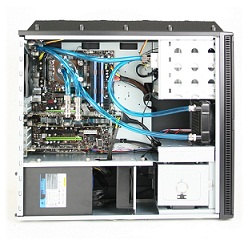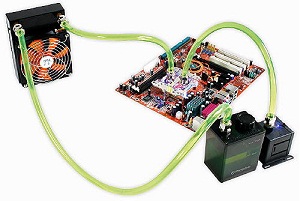Every computer from the smallest of home theatre Computers to most hulking of gargantuan gaming rigs generates heat during operation, heat that can kill your Computer's precious internals if you are not careful.

While you do not have anything to worry about if you bought your computer from a big-box retailer or straight from a manufacturer like HP you will be faced with a potentially crucial decision if you are building (or custom-buying) a fire-breathing, benchmark-eating computer: Should you chill your computer with a traditional air cooling solution or a pricier. Is there more efficient liquid-cooling system? This question has much aspect to consider before you can answer it.
Cooling methods explained:
Secret to harnessing cooling power of air lies in fans - lots of fans. Your typical air-cooled COMPUTER is packed with case fans, graphics card fans also a CPU fan or 2 positioned a top a big metal heat sink to keep your expensive components nice also frosty.
A water-cooling system, on the other hand, employs a series of coolant-filled tubes, a radiator, water blocks the equivalent of heat sinks also a couple of other components to keep your computer feeling refreshed. You will even need a few fans to push around all the water! Our guide to setting up a liquid-cooled computer explains a basic system in exacting detail.
Got it? Good. Defining air cooling also liquid cooling is the easy part. Trickier bit is manufacturing the decision to use one or the other.
Water cooling pros:
Act of switching from air to liquid cooling represent a personal milestone in one's computer-building life. You, young computer Padawan, are now a desktop Jedi.
Let's start with the pleasant bits. One of the key benefits of a strong liquid cooling setup is that it allows you to cool specific system components to a greater degree than if were you to use fans-not the most applicable setup for someone running a typical stock-clock processor however one that's definitely of interest to anyone looking to over clock their chips a bit (or a ton).
Even if you do not tax your rig enough to need a bigger cooling boost, a cheap self-contained water cooling loop-more on those later-can help lower your Computer's sound output. Water cooling is much quieter compared to stuffing your case full of fans.
There's also the issue of space. A enormous heat-sink-fan combination might perform well enough however the best CPU coolers eat up a ton of real estate inside your case. Liquid cooling requires much less space also it looks a lot niftier to boot. You can't discount the cool factor of a case full of colourful, liquid-filled tubes!
Water cooling cons:
Big drawback of water cooling is its comparatively high cost, especially if you are looking to build a custom setup. While most traditional upper-end CPU coolers cost somewhere between $50 also $100, building a liquid-cooling setup can cost far more. For example, EK Water Blocks' top-tier H3O 360 HFX water cooling kit costs a whopping $360. Price is converted from Euros, so the 360 in the name may be coincidental.
Quality matters in a liquid-cooling setup: You do not need to buy cheap parts to save a few bucks also end up dousing your pricey computer components in brightly hued coolant.
Drawback is homework concerned. Generating the parts list is going to take a little planning if you are not buying a pre-packaged kit. You will have to pick up a water block for your CPU that fits its socket, fittings that match your block also tubing size, the tubing itself, a pump, a reservoir, a radiator, a fan (or fans) for the radiator also the coolant itself. Also that's just a typical setup for the most bare-bones configuration you can build. If you need to power separate loops for your motherboard, video card, hard drives or RAM you will have to do even more planning also purchasing.
You will also have to make sure you have room for your setup. Radiators typically need open fan slots on your case. Reservoirs require space in your case as well also you will have to plan out your loop's layout so that you can actually get it up also running ("priming" the pump, so to speak) when you fill it with coolant. In other words, your water-cooling loop does you no good if you do not have a good way to get the fluid running around!
Then there's the installation itself. Basically put your first adventures in water-cooling land could very well be fraught with peril. Installing loops isn't exactly newbie-friendly also the process might be more involved than you are comfortable with, even if you've installed a typical fan-based aftermarket CPU cooler or two.
Which reminds me: Connecting your tubing also fittings in a secure also safe fashion is going to be your number-one issue when building your first water-cooling setup. You'll spring a leak in some fashion. You will need to construct also test your liquid-cooling system outside of your computer to ensure its fortitude before installing it around your expensive electronics. Component manufacturers aren't likely to replace flooded electronics also the manufacturers of your water cooling parts certainly aren't going to foot the bill.
Self-contained liquid coolers:

Antec's Kühler H2O 620 sealed liquid cooler: Water cooling in a box.
If all this talk of water cooling's complexity has left your head spinning a bit, fear not: Another solution is available.
Self-contained or "sealed" liquid-cooling kits-preassembled also completely sealed, they start at around just $60-allow you gather profit of a simple water-cooling setup without having to deal with any of the messy particulars. You just need to attach a water block to your CPU also a radiator/fan combination to your case also you are off to the races, with nary a drop of coolant to worry about. You may lose customization options if you use self-contained kits like Corsair's Hydro H-series or NZXT's Kraken-series coolers however you also lose most of the headaches typically associated with do-it-yourself liquid cooling. Leakage is highly unlikely as long as you do not bend or twist the tubing at sharp, weird angles.
Inaugurating a self-contained liquid-cooling kit is about on a par with the difficulty of installing an aftermarket cooler for your CPU. If you need to water-cool only you're over clocked processor, a sealed liquid cooler is a compelling option. Stick to DIY loops if you need to liquid-cool more than the single component, however-or if you need the bling factor of clear tubes filled with colourful coolant. On the whole of the sealed coolers are opaque.
Conclusion:
Do you need a Water cooling or Air cooling? The answer depends on your particular usage requirements.
When it comes to case cooling one size does not fit all however most people can get by with fans alone. It's easy also it's cheap. If, on the other hand, you are an enthusiast who needs the best cooling possible for your flaming CPU also a gaggle of graphics cards, a DIY water-cooling setup is in your future. Finally, try a sealed liquid cooler if you are considering liquid cooling either to keep your over clocked processor chilled or simply to benefit from reduced system noise.